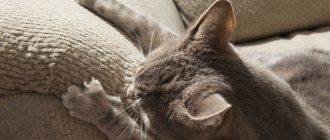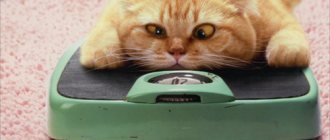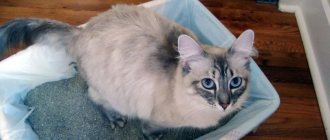The structure of cat claws
Many who have tried to figure out how to trim a cat’s claws know that the structure of a cat’s nails is different from human nails. For us, cutting our nails is a simple procedure; it can only hurt if we cut them too short. Cats have pulp in their claws - living tissue riddled with blood vessels, this is common to all cats. If you cut off too much, the claw will bleed and it will be painful for the animal to walk. In addition, such a wound on the paw is an open gate for infection.
Due to the peculiarities of the structure, many people are concerned about the question of whether it is possible to trim cats’ claws. This can be done, but only very carefully and with special tools. If the owner is doing this for the first time, it is better if a veterinarian or groomer shows him how to trim the nails without the slightest harm. Many pet salons offer this service, so trimming can be done along with other care - washing and combing the fur, cleaning the ears.
INTERESTING TO LEARN: How to give a cat an injection correctly
“Reinforced concrete” materials
Surely you are now wondering what to do? Anti-scratchers are inconvenient, sprays don’t work, and declawing is a completely inhumane method. It turns out that there are materials to which cats are absolutely indifferent.
Is there wallpaper that cannot be peeled or torn?
To protect yourself and your pet from problems, you can use the miracle wallpaper that technologists created specifically for such cases (most often they are called just that: anti-scratch, scratch-resistant).
From the huge variety of decorative wall coverings, it is better to choose ones that the kitten cannot tear up. This way you will save yourself nerves and money. Such wallpapers are, of course, more expensive than ordinary ones, but they will serve faithfully much longer.
Another life hack!
Cats are most often interested in “soft” wallpaper, into which the claw enters and gently moves down. Vinyl wallpaper does not have such a nice feel.
Miracle material for furniture: flock
As you probably understand, the wonders of this material lie in the fact that cats do not tear at it. Why they don’t like him remains a mystery that we don’t need to solve. When choosing upholstered furniture, it is best to give preference to furniture covered with flock.
And if buying new furniture was not included in your plans, then use covers made of the same material.
How to train a cat to trim
In addition to knowledge of how to properly trim a cat’s claws, the owner of the animal will need a lot of patience and love, because trimming cats’ claws is an activity that requires endurance and calm. Many people are generally interested in whether a cat’s claws need to be trimmed. Indeed, this procedure is not necessary if the cat is accustomed to using a scratching post and does not touch furniture, wallpaper and curtains. If owners want to keep their interior in perfect order and the cat’s health strong, then they will have to work hard.
It is best to start cutting kittens' claws from a very early age, then they will get used to the procedure and will not resist it too much. After finishing the grooming, give the kitten a treat, then he will associate the procedure with pleasant treats.
Is it possible to trim nails if the cat is not in the mood or resists? You shouldn’t do this, because if you insist and she doesn’t give in, then she will subsequently associate the procedure with unpleasant sensations. It is better to trim the claws when the animal is relaxed or sleeping. An angry or overexcited cat may perceive the owners’ attempts to pick it up as aggression and may bite or scratch while escaping.
Claws as a natural means of attack, defense and a tool for practical use
The ancestors of cats were nocturnal, living in savannas and semi-deserts, spending part of their time in trees. Small, but very tenacious and strong claws in the shape of Turkish scimitars helped them deftly and quickly climb branches, escaping from larger predators, serving as means of defense and helping to retain prey.
Today, domestic cats remain essentially the same small, dangerous predators. Pets need claws for normal movement, as they serve as a kind of stoppers that prevent sliding, and also help to climb various surfaces.
Cats have 5 toes on their front paws, and 4 on their hind paws, plus one vestigial one. There are 18 claws in total and they are constantly growing. To get rid of the old part of the horny tissue and keep the “equipment” constantly sharp, cats need to sharpen their claws. It is for this purpose that the “scratching post” is used. It should be large enough so that the animal, stretching out to its full height, can sharpen its claws heartily.
If you do not take care of purchasing such a device and do not train your pet to use it, you should not be surprised that it will begin to damage furniture, carpets, wooden trim, door frames, and so on. If you provide the animal with the necessary “tools”, it will not cause mischief. So there is no need to get rid of the natural tool of attack and defense.
If you do not provide the cat with the necessary accessories, events can go according to two scenarios:
- A well-mannered, good-natured creature will not harm the owner’s property, but will suffer itself. Very long claws, without constant grinding, grow strongly, bend and can dig into the pad or into the skin fold between the fingers. This can cause serious inflammation and suppuration. In severe cases, the infection penetrates the bone, “melting” it, and the cat may lose a finger. Such a defect will negatively affect its gait, agility and ability to hunt. In the wild, the injured animal would not have survived.
- If necessary, cats deftly give themselves a “manicure” by biting off the offending part of the claw. But it still needs to be ground off, because sharp debris can injure the cat itself or the pets. In the absence of a “claw”, its role will be played by completely inappropriate and unintended objects. Owners should not be surprised or indignant if a cat tears a chair, the upholstery of an expensive leather sofa, or scratches the legs of valuable wooden furniture.
If no amount of effort can be used to wean the animal from encroaching on the property of its owners, and the cat stubbornly ignores all tools, practicing only on Persian carpets, you will have to resort to a last resort - trimming its claws. This is an important and responsible operation, and you need to be able to do it correctly.
Rules for pruning
The main rule in such a situation is to treat the animal with care. To figure out how to properly trim a cat’s claws, you just need to act consistently and carefully:
- Pet and calm the cat. If he is aggressive in nature or too shy, it is best if he is held by another person. You can also wrap the cat tightly in a terry towel.
- It is best to cut in good light, near a window or under directional lighting. It clearly shows where the blood vessel passes in the claw.
- If a cat has fluffy “insulation” between the pads of its toes, it is better to cut it off so that it does not interfere.
- In order for the claws to move out of the protective covers, you need to gently press on the base of the finger.
- Quickly but carefully cut off the protruding part - literally a few millimeters.
- Give the cat a treat.
INTERESTING TO KNOW: How to get rid of the smell of cat urine in shoes
Trimming overgrown claws on cats at home will not be difficult if you act gently and delicately, and repeat the process regularly, avoiding excessive regrowth, then the animal will treat it calmly.
scratching post
Monthly nail trimming does not always relieve your cat of the need to take care of her claws on her own. If you see that your pet, despite timely care, periodically looks for materials on which it wants to “practice,” then it makes sense to think about buying a scratching post. A scratching post will allow the cat’s other needs, which we talked about earlier, to be realized. Marking territory, kneading muscles, grinding claws - all this will be provided by a scratching post for your pet.
A flat scratching post is a convenient place to start introducing your cat to such devices.
Please note that not all cats accept scratching posts. There are times when owners, having bought a huge gaming complex for their cat, sell it as completely unnecessary. To decide whether your pet is interested in this type of leisure activity, you can start by getting acquainted with such a simple and cheap option as a flat scratching post. It is upholstered with a special hard material that allows the cat to successfully tear at it. Attached to some vertical surface, it will give your dog an initial idea of scratching posts and allow you to predict his reaction to such devices.
For some cats, the purpose of the scratching post remains a mystery.
A flat scratching post needs to be hung high enough so that the cat can stretch all its muscles while sharpening its claws. The minimum mounting height for such a scratching post is eighty centimeters.
Types of scratching posts
In addition to the flat version, there are the following types of scratching posts:
- Post – A cylindrical post covered with a stiff material (such as jute). At the top of such a pillar there is usually a platform on which the pet can climb if desired. Sometimes the posts are equipped with additional toys to attract attention, sometimes they make do with a minimalist design. You can make a claw post with your own hands by taking a leg from a table or coffee table and upholstering it with the appropriate type of fabric;
The stand is suitable for both adults and little ones
- A scratching post built into the play complex. On the Internet you can find many design solutions for the location of entire cat “palaces” in apartments. They combine posts, flat scratching posts, beds, and everything you can imagine. It would seem that the cat’s leisure time in such conditions is guaranteed, but sometimes it happens that the pet remains completely indifferent to such “architectural ensembles” in his honor;
Play complexes are upholstered with the same materials as flat scratching posts
What to do if the pulp is damaged
Trimming nails on domestic cats can damage a blood vessel. First of all, you need to stop the bleeding. This can be done using hydrogen peroxide. Then the cut area is sprinkled with talcum powder, you can use baby powder. The resulting dense “lump” clogs the capillary and leads to blood stoppage.
If you cut your cat's nails when she is struggling, you can damage the pad of the toe. The wound is cauterized with iodine and further care is taken to ensure that it does not fester. If the bleeding cannot be stopped, you will have to go to the veterinarian.
Before cutting, all tools must be treated with disinfectant solutions. Liquids for manicure tools or alcohol are suitable.
Frequency of procedure
To the question of how often you can cut a cat’s claws, you can answer this: as they grow. The normal frequency would be once every 14 to 20 days. The main condition is to do this regularly, otherwise the cat will simply wean itself off the procedure and will be extremely dissatisfied with it.
Carrying out the process carefully does not injure the animal and will not cause negative emotions. The owner must do this with love, and if he does not succeed, he can always contact a veterinarian or a specialized salon.
Additional Tips
By taking your pet into your home, you have taken responsibility for its health. Timely trimming of claws is part of pet care. To keep your cat healthy, it is important to know the following rules:
- Monitor the condition of your paws. All pets are individual. To determine whether your pet needs nail trimming, you need to examine it periodically.
- Have iodine, antiseptic and zinc-based powder so that in case of a cut, disinfect the wound.
- Buy a nail clipper. These include pruners, blisters, guillotines and trimmers.
- Carry out the procedure if the pet feels safe.
- Talk to him while cutting his hair and distract him with something interesting.
- If you doubt your abilities, you should contact a veterinary clinic.
Treat your pets with tenderness and care so that they feel your love.











